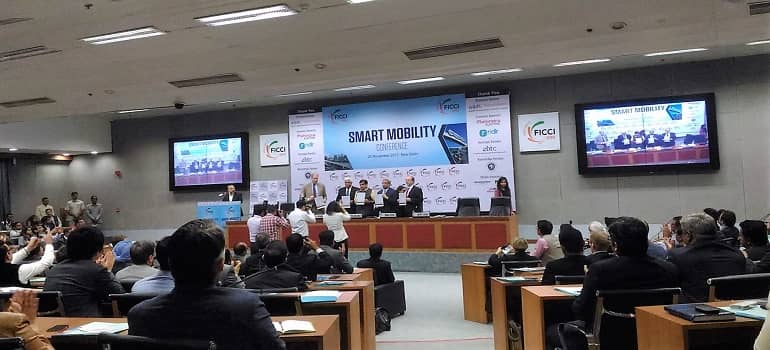
Overcoming key barriers to vehicle electrification in India’s passenger mobility sector presents an enormous challenge for India—and also a tremendous economic opportunity. India can leapfrog the western mobility paradigm of private-vehicle ownership and create a shared, electric and connected mobility system, saving 876 million metric tons of oil equivalent, worth US$330 billion (INR 20 lakh crore) and 1 giga-tonne of carbon-dioxide emissions by 2030.
A FICCI – Rocky Mountain Institute report titled ‘Enabling India’s Transition to Electric Mobility’ was released by the Union Minister Nitin Gadkari at a conference on smart mobility, arranged by FICCI in New Delhi today.
Using a collaborative approach, coordinated action and the strategies and solutions in this report, India can overcome key barriers to EV adoption and potentially become a global leader in electric mobility.
Estimates indicate that India’s urban population will nearly double in the next decade, to approximately 600 million in 2030 and forecasts suggest that by then India’s urban population will take almost 500 million trips per day. While this rapid growth presents major policy and business challenges for India’s public and private sectors, respectively, it also presents an enormous economic opportunity. Optimizing e-mobility use for everyday life with greater thrust on use of public transport, e-vehicles, metro solutions and shared rides as means for mass transit could also prove game-changers in addressing the issue of air pollution in urban areas.
India’s transition to a shared, electric, and connected mobility system can save US$330 billion (INR 20 lakh crore) by 2030 on avoided oil imports alone.
If India is successful in reaching its EV target, the market could be enormous. Even under a shared mobility paradigm, over 46,000,000 vehicles (two-, three-, and four wheelers) could be sold in 2030. This annual market size would present an opportunity for Indian companies to become leaders in EV technology on a global scale.
By 2027, 4-wheel EV sales may exceed 4-wheel ICE sales. After this intersection point, 4-wheel EV sales will grow rapidly, with nearly 16 million 4-wheel EV sales in 2030. While achieving 100% EV sales by 2030 is challenging, doing so would create a major business opportunity for automakers. Realizing this goal would have a significant impact on India’s vehicle stock, with a nearly equal split between ICEs and EVs by 2030 in the 4-wheel segment.

One by one, the main barriers to EV adoption — price, selection, range, charging, and consumer awareness — are falling due to steeply falling technology costs, business model innovation, and increasing connectivity. India can accelerate its EV adoption by addressing these key challenges through a whole-systems approach. This report discusses potential solutions to these challenges across six areas of the passenger mobility sector:
Public Transport, to reduce congestion on roads, the cost of transportation for travelers, transportation energy use, and negative environmental impacts
Sharing and mobility services, to unlock the competitive and often superior economics of high-mileage EVs through a variety of innovative business models, while creating jobs and enhancing access to India’s critical public transit network;
Interoperable transit data, to enable sharing and mobility services, as well as better access, affordability, and multimodal integration;
EV charging infrastructure, to power EVs and to provide valuable grid services, reducing customers’ concerns around range anxiety and enhancing India’s rapidly changing electric grid;
Battery swapping, to reduce the upfront cost of EVs and to complement EV charging infrastructure through a more centralized, less distributed form of charging EV batteries; and
Battery manufacturing, to reduce the cost of batteries—currently the most expensive EV component—and to make them in India, thereby accelerating EV adoption, both in India and globally, while creating jobs and avoiding a future in which India replaces costly oil imports with lithium imports.
“The FICCI-RMI report on ‘Enabling the Transition to Electric Mobility in India’ highlights the way forward to accelerate electric mobility in India while addressing the key areas of shared mobility services, interoperable transport data, EV charging infrastructure and manufacturing”, said K Ramchand, Chairman, FICCI National Committee on Infrastructure and Managing Director, IL&FS Transportation Networks Ltd.
Amory Lovins, Co-Founder and Chief Scientist, Rocky Mountain Institute stated, “Recently, global solar PV and battery prices have dropped 80% in five years. Signs indicate that the pace of India’s energy transformation could be astonishing: the nation singlehandedly reduced the cost of LEDs by 80% in one year, and the Government of India has set its sights on an ambitious target of 100% electric vehicles by 2030”.

